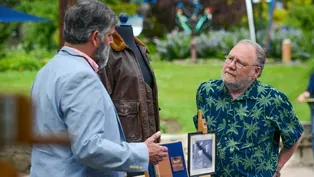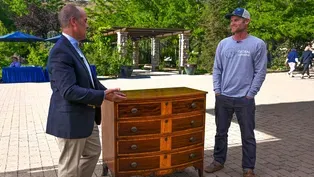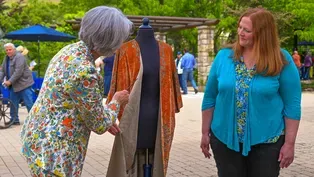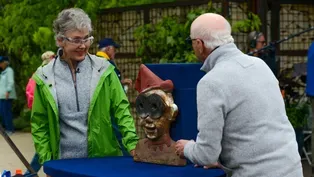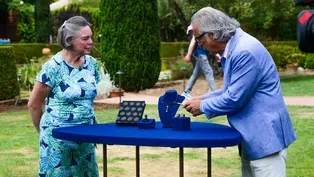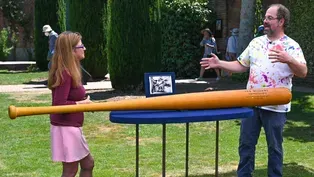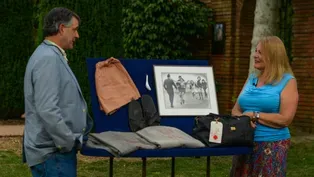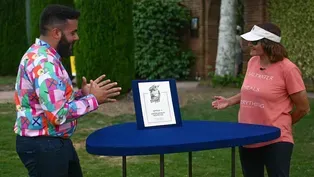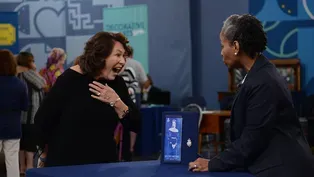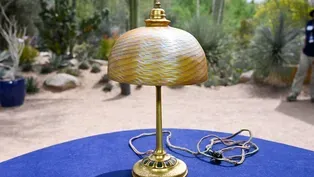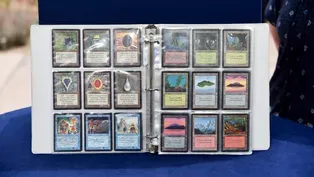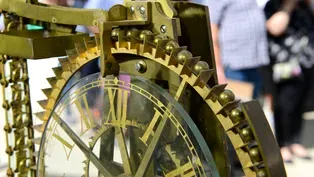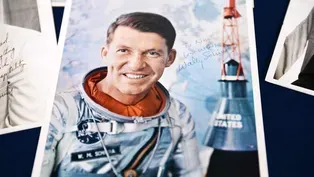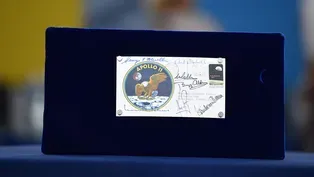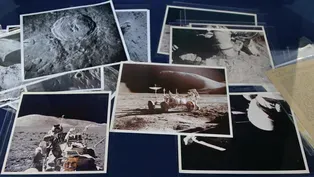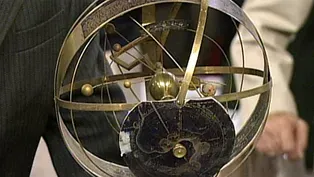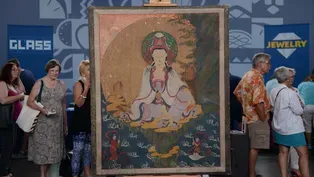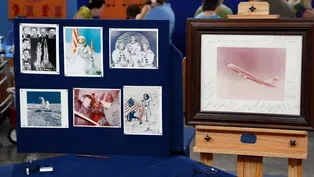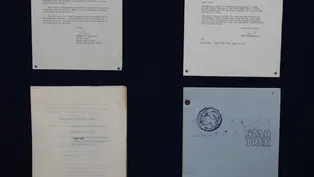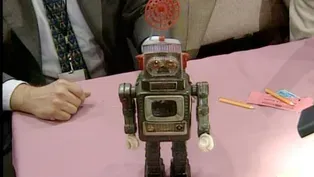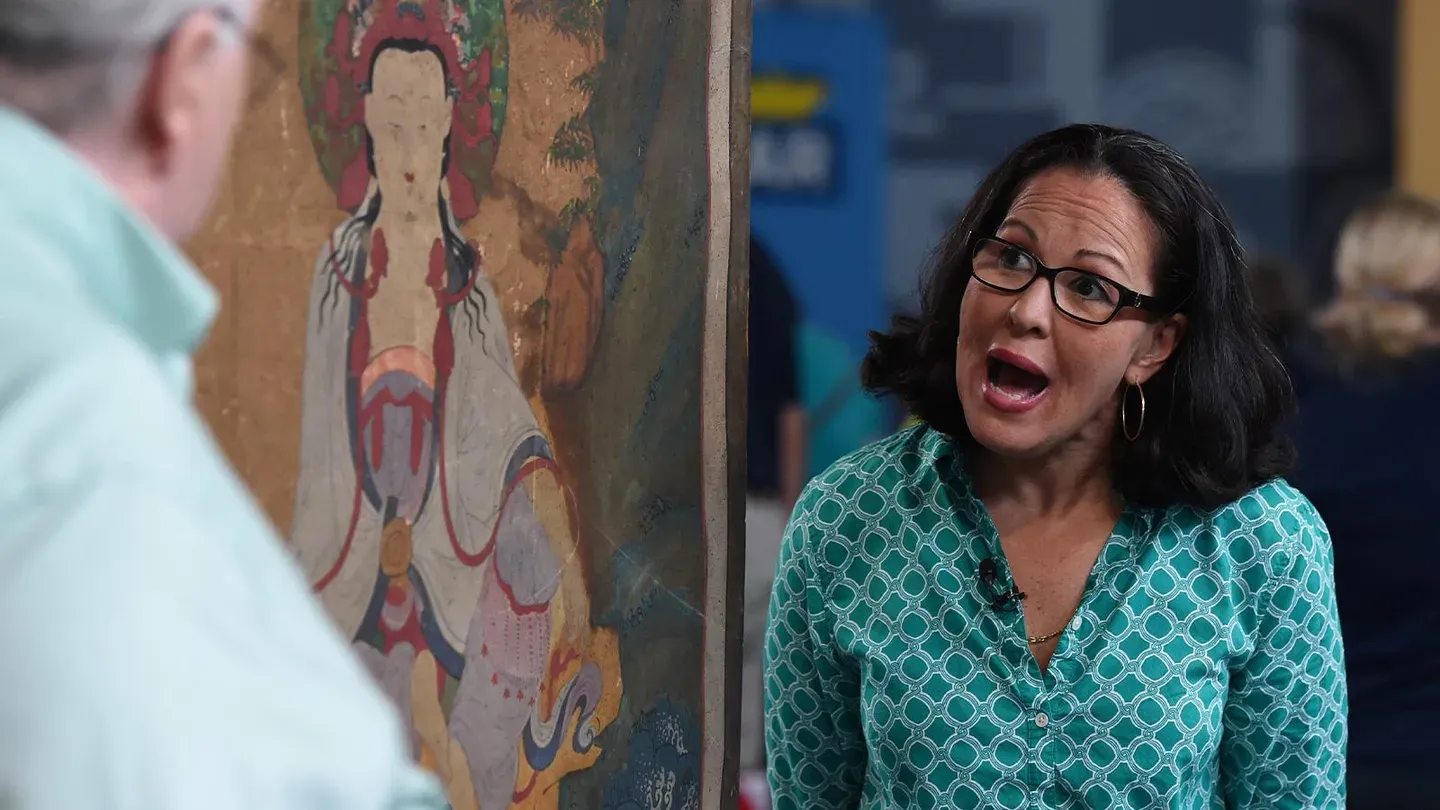

RECUT: Out of this World, Part 1
Special | 21m 47sVideo has Closed Captions
Blast off to a half-hour of ANTIQUES ROADSHOW and discover stellar space-themed treasures!
Blast off to a half-hour of ANTIQUES ROADSHOW and discover stellar space-themed treasures including NASA Space Program autographed photos, a Star Trek treatment, script, and letters, and a celestial indicator made around 1872!
Funding for ANTIQUES ROADSHOW is provided by Ancestry and American Cruise Lines. Additional funding is provided by public television viewers.

RECUT: Out of this World, Part 1
Special | 21m 47sVideo has Closed Captions
Blast off to a half-hour of ANTIQUES ROADSHOW and discover stellar space-themed treasures including NASA Space Program autographed photos, a Star Trek treatment, script, and letters, and a celestial indicator made around 1872!
How to Watch Antiques Roadshow
Antiques Roadshow is available to stream on pbs.org and the free PBS App, available on iPhone, Apple TV, Android TV, Android smartphones, Amazon Fire TV, Amazon Fire Tablet, Roku, Samsung Smart TV, and Vizio.
Buy Now
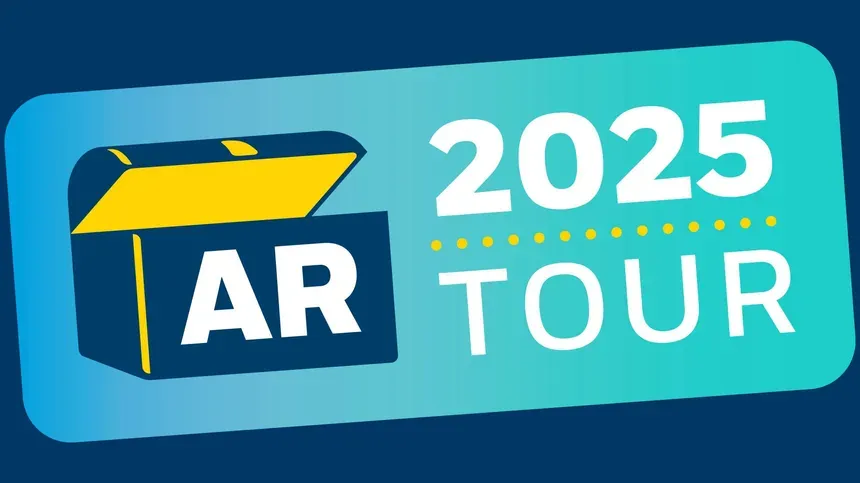
ANTIQUES ROADSHOW 2025 Tour!
Enter now for a chance to win free tickets to ANTIQUES ROADSHOW's 2025 Tour! Plus, see which cities we're headed to!Providing Support for PBS.org
Learn Moreabout PBS online sponsorshipMore from This Collection
RECUT: Idaho Botanical Garden, Part 4
Video has Closed Captions
Wrap up Season 4 of RECUT with a $50,000 appraisal at Idaho Botanical Garden! (22m 31s)
RECUT: Idaho Botanical Garden, Part 3
Video has Closed Captions
Visit the “City of Trees” for unbe-leaf-able Boise treasures in this half-hour RECUT. (22m 31s)
RECUT: Idaho Botanical Garden, Part 2
Video has Closed Captions
In this half-hour RECUT, watch breathtaking Boise appraisals at Idaho Botanical Garden. (22m 31s)
RECUT: Idaho Botanical Garden, Part 1
Video has Closed Captions
Gem State treasures sparkle in this half-hour RECUT at Idaho Botanical Garden! (22m 31s)
Video has Closed Captions
Watch wow-worthy Woodside finds in this half-hour RECUT and learn which is up to $44,000! (22m 24s)
Video has Closed Captions
In this half-hour RECUT episode, golden state treasures shine at Filoli. One is $150,000! (22m 23s)
Video has Closed Captions
Watch fascinating Filoli finds in this half-hour RECUT, including one up to $100,000! (22m 36s)
Video has Closed Captions
This season's first half-hour of RECUT wows our guests with a $200,000 to $330,000 find! (22m 30s)
RECUT: American Stories, Part 1
Video has Closed Captions
Learn the stories of objects that represent American traditions and triumphs! (22m 28s)
RECUT: Desert Botanical Garden, Part 2
Video has Closed Captions
Phoenix treasures heat up, like one appraisal up to $35,000, in this half-hour RECUT! (22m 28s)
RECUT: Desert Botanical Garden, Part 1
Video has Closed Captions
Phenomenal Phoenix finds abound in this half-hour RECUT. One is worth up to $100,000! (22m 26s)
RECUT: Crocker Art Museum, Part 2
Video has Closed Captions
See stunning Sacramento finds like one $80,000-$125,000 treasure, in this half-hour RECUT! (22m 28s)
Providing Support for PBS.org
Learn Moreabout PBS online sponsorship♪ ♪ CORAL PEÑA: "Antiques Roadshow Recut" is over the moon for this collection of treasures.
MAN: They were able to get a couple corned beef sandwiches into the flight suit pockets.
For 16 years, I flew NASA's airplane, the Vomit Comet.
PEÑA: It's "Antiques Roadshow Recut: Out of this World."
♪ ♪ PEÑA: Human beings' fascination with outer space has inspired incredible art, amazing technologies, and has ignited people's imaginations all over the world.
From the history of space exploration to the fantasy of science fiction, we've got a spectacular episode of space-related treasures to share.
Check out this appraisal with a guest whose connection to NASA goes back to the organization's early days.
For 16 years, I was one of the test directors on the NASA zero-G airplane, lovingly called the Vomit Comet.
We flew parabolic trajectories to simulate zero-gravity, or lunar gravity, as required.
And this particular one was given to me when I retired in 1977.
It has 16 different astronaut signatures on there, plus some of my co-workers.
And how did you first become involved?
Through an accident.
They were looking for volunteers, and I raised my hand, and we went from there.
And when was that, what year?
I started in the, in this program in '62.
I went to work for NASA, which was then called N.A.C.A.
at the time, in 1954.
I either was wearing a spacesuit, developing the lunar surface hardware, or training astronauts.
What you can tell me about this photo here?
That is Al Shepard.
I don't have his autograph on there.
But, you know, Al was the first American in space.
We practiced everything, and that's Shepard deploying an American flag that he later deployed on the moon.
And tell me about the photo here.
That's me on the left, and that's Marsha Ivins on the right.
Marsha was an engineer with NASA beginning about 1974.
And I worked with her several, on several occasions on the airplane.
And when I left in 1977, shortly after I left, she became an astronaut and flew on five shuttle missions.
Now, most of the photographs are personalized to you.
Yes.
So you obtained these in person.
In person.
Yeah, yeah.
Or in the case of that one, I took it to the astronaut office and left it there, and they signed it.
You do have some in your collection that are auto pen.
Right.
But the good majority of them are actually signed by the astronauts.
Yeah.
Tell me about the photo here of Gordon Cooper.
It was a standard public release photograph, and I just took it up to the astronaut office, and he signed it.
What's your favorite memory of the Vomit Comet?
We occasionally flew celebrities.
Probably my favorite celebrity was Bozo the Clown.
The real Larry Harmon flew with us one time.
That was fun.
And how did he do on the flight?
He did okay.
What would you say is your most memorable event?
The day before the day before Apollo 11, we flew with Armstrong and Aldrin on their final training mission for the Apollo 11 flight.
Buzz tried to do backflips.
He made it on one of them, but it was a little bit scary to me, because my job was to make sure he didn't get hurt.
Have you ever had these items appraised before?
No.
Well, we've selected some of them to bring out today, as well as, you also have, though, a fabulous album with a couple dozen more images as part of your collection.
Oh, yeah.
Many of them are signed, some aren't signed.
As far as value, starting with the Mercury 7 photo... Mm-hmm.
At auction, this photo would sell for between $3,000 and $5,000.
On the Gordon Cooper photo, this one we would expect to sell for $500 to $1,000.
Okay.
The photo of Al Shepard I would expect to sell for between $200 to $400.
The photo of you with Marsha Ivins, I would put a value of $200 to $400, as well.
On the Apollo 11 signed photos, signed by all three of the astronauts there...
Right.
We would expect those to sell for between $3,000 and $5,000 each.
Wow!
You...
Your Vomit Comet photo, with all the signatures there, that would sell for between $3,000 and $4,000.
Wow, that's amazing.
The collection in total, we would put an estimate between $35,000 and $45,000 at auction.
Yeah.
You got to be kidding.
It's a great collection.
I am...
I am just speechless.
I thought maybe $2,000, $3,000, $4,000, maybe, something like that.
Yeah, thank you for bringing it.
Well, thank you.
WOMAN: It belonged to my cousin, and it was his great-grandfather that invented this.
And they made them in Hartford, Connecticut.
APPRAISER: And you've just always had it.
I've had this one about 20 years.
Right.
Yeah, yeah and I just opened it about two months ago when I learned that you were coming.
Really?
Wonderful, well, I'm very glad you did.
This is known as a celestial indicator, and it's fascinating, because not only is it in good condition, you've got the instruction sheet, and you've got the original packing case, which is very rare, and it even has got the maker's name, and says that it was made here in Hartford.
So it's got local history as well as technical history and scientific history.
Uh-huh.
These were used for demonstrating to children, to schools, and to adults how the solar system worked.
Mm-hmm.
And you turn that knob, and in the center, you have the sun, then Mercury, Venus.
After that, our own planet Earth right there.
It's suffered a little bit of damage.
It's lost the paper gores.
Our own moon, which can move.
If this were working properly, the moon would orbit the Earth, as well.
Yeah, uh-huh.
And then Mars, Jupiter, and so forth.
In fact, as you notice, there are less planets here than we now know are actually in the solar system.
That's true.
The piece is over 100 years old.
It's constructed from lacquered brass on a painted cast-iron base.
Now, according to our little instruction sheet here, you could have gotten a fancier cast-iron base with florid decoration.
Uh-huh.
Along the outer edge, you have the stars, the constellations.
It's a great example of Victorian technology, and they're very, very collectible today.
At auction of science and technology, I would not be surprised to see this sell for between $3,000 and $5,000.
(laughing): Oh, I'm surprised.
Good.
When they were made they were $25.
Exactly.
According to that.
My dad used to work at a movie theater back in the '70s.
APPRAISER: And there's, like, thousands of variations of these posters.
You'll find every incarnation.
APPRAISER: It's actually a Timby solar clock.
The globe would rotate as the clock was telling time.
The Timbys were manufactured between 1863 and 1865.
Today's valuation is about $4,500 at auction.
Interesting.
APPRAISER: Looks like a flower or something, right?
Yeah.
It's not.
Imagine this in 1835... shooting through the night sky.
It's Halley's Comet, and you've got about a carat worth of diamonds in there.
If you had to go into a store to buy this, it could be, retail, $1,500.
(breathlessly): Wow!
I would say that this one's probably '58 to around '62 or '63, maybe a little bit later, because of the... because of the plastic in the back.
They would have used just tin in earlier robots, for the most part.
So he's probably into the '60s sometime.
But you told me a story, you said that you couldn't get him to work.
MAN: Yeah, when I first got him, the part up here was hanging down on the side.
And I knew it went in here.
Right.
But I was looking for a switch, and I could never figure out where the switch was.
And one day, I just pushed him down, and he took off running.
(laughing): That's great!
(robot whirring) My family has been kind of indirectly associated with the space race for years and years.
My father was a manager of a hotel that was partially owned by the seven original Mercury astronauts.
And through that friendship, he got to meet a lot of the other people and become friends with different astronauts.
And subsequently some stories came out of it, and ultimately, that's why we're here.
Yes, I have a collection of a lot of different astronauts and autographs and all that, but I think it's, it's the story behind it that really made it interesting for us.
Interesting childhood for my sister, myself.
There'd be dignitaries coming in because it was so fresh and new to the U.S., that at one point we were told to try to keep the kids of Wernher von Braun busy.
Went bowling with his kids.
You've got an incredible collection of items here, and I only chose a few for us to actually look at today.
Yeah, yeah.
We've got this great photograph of your dad in front of the hotel.
But it's got something interesting on the sign here.
"Try our cornbeef, it is out of this world."
There are stories that... kind of, came and went a little bit over the course of, you know, a few decades now.
They've changed a little, but my father has recently passed, and there's no longer going to be another congressional investigation.
But what had happened was, Dad and John Young were talking about the food that they had to eat-- emulsified, reconstituted stuff in bags and packages, that... And Dad said, "Well, John, if you'd let me know, I could have catered it from Wolfie's," which is a great delicatessen in the Ramada Inn here in Cocoa Beach.
Well, out of that, these two got together, and they tried to figure out a way that they could get a couple of corned beef sandwiches into space.
From there, Dad and John went into the kitchen, took a full thick slice of corned beef, and then they started wrapping it in cellophane.
They'd go to the top of a six-foot ladder, and they would drop it.
"Okay, it's going to hold together."
Well, there was no Ziploc bags back then, so this is how it had to be done.
Well, I think with Wally Schirra's help, they were able to get a couple of corned beef sandwiches into the flight suit front pockets.
And the joke was going to be, to Gus, basically-- he knew nothing about it.
Gus Grissom and John Young were going to be on this flight.
He was going to say, "Gus, what do you want on that corned beef sandwich?"
Well, they pulled it out, and the sandwiches just disintegrated.
There was caraway seeds and crumbs and everything everywhere.
And nobody probably would have heard anything about this had that not gotten back down to ground.
They had the capsule on the top of the carrier, and as they were taking photos, there was crumbs and stuff everywhere.
Well, out of that, there was a congressional investigation that, I don't really know where it went too far.
But things were changed around to keep my dad's name out of it at that time.
Well, it's fantastic, I mean, one of the aims of the Gemini 3 mission was to test different foods in space.
And to have a corned beef sandwich brought on board along with all these emulsified glycerin-covered foods... Sure, yeah, yeah.
I can see why the government might get a little upset and decide to do a little bit of an investigation about it.
Stuff was put in jeopardy, no doubt, but thankfully, no harm, no foul on that one, so... Well, it seemed to go over pretty well.
And it wasn't the last time that John Young brought a corned beef sandwich into space.
On his first Space Shuttle mission... Uh-huh.
They actually had corned beef sandwiches on board.
You've got this great letter from Alan Shepard to your dad on the Ramada Inn stationery.
It says, "Carlos, I needed a corned beef sandwich, and all I got was baloney."
It kind of corroborated what transpired.
Yeah.
We also chose two photographs.
Mm-hmm.
Both signed by Neil Armstrong, dedicated to your father and mother.
Mom and Dad, yeah.
And to you.
Correct, yeah.
As a kid.
This is an incredible collection.
The photograph, it's wonderful that it has Wolfie's, where the sandwiches supposedly came from.
And then we have this great letter on the letterhead, signed by Alan Shepard to your dad.
We estimate, at auction, this would sell for between $3,000 and $5,000.
(laughs): Too fun, too fun.
Just for this great little slice of astronaut history.
Yeah.
And now we have these two other photographs here.
These are some of the earliest signed photographs, with the NASA background, of Neil Armstrong.
We estimate, at auction, each one would sell for between $7,000 and $10,000 each.
Chair, please.
(laughs) Very good, very good.
No clue it was going to be anything like that.
It's a great young picture of him.
And we look at this entire collection.
There is so much here from the early astronaut days.
As a whole, we'd estimate around $40,000 to $50,000.
Wow, wow.
Thanks, Dad.
WOMAN: They're all related to the first series of "Star Trek."
My father was a nuclear physicist, and a colleague of his who worked in the nuclear program headquarters in New Mexico sent him a letter with the pitch and asked him to take a look at it, and said that he thought that Gene Roddenberry was probably looking for technical advisers.
So my father looked at that, and, and he met Gene Roddenberry.
And then later that year, Gene Roddenberry sent him a letter with the original script for the first show.
And that, that letter is up here.
That letter's here.
Okay.
And then the script for the first show here, and most people with "Star Trek" know that that was never aired the way it was.
Captain Kirk's original name was Captain April, which... wouldn't have made it, I don't think.
Well, that's one of many things that changed.
If we look at the date, this letter was written in May of 1964.
Right.
And the date on this piece, it originated in March of 1964.
Mm-hmm.
So this is the original typed-up pitch that Roddenberry gave to Desilu Productions.
And it's full of all of these wonderful pieces of hyperbole that "Star Trek" fans through the years have latched onto.
(laughs) The main one is, he describes it in the opening sentences of his pitch.
This is his description of what the show's going to be like to try and get funding.
His tag line is, "It's the wagon train to the stars."
Right.
Which all the "Star Trek" fans really got, and now go back and laugh about.
The fans know about this.
A copy of it exists You can actually go online, if someone's interested in reading this, and find some of the blogs.
But the best part about that is that the known copy is actually Gene Roddenberry's copy.
Can't find one that's ever sold.
I even called some other colleagues who are also "Star Trek" fanatics who work in this world, and none of us have ever heard of one coming up for auction.
This is hard proof that Roddenberry really did want the science to be right.
Mm-hmm.
He was reaching out to people like your father, who was a rocket scientist, really.
Mm-hmm.
And it's even funny, he used in his pitch the Drake Equation, which was the equation for a Dr. Frank Drake, which was an equation to come up with how many intelligent life forms might be in the universe, based on planets.
He didn't actually know the equation at the time, so I love the fact that your father, being a scientist-- we have notes here, "Temporary.
Get correct formula."
Mm-hmm.
Posters have been made of this.
They call this the second variation.
Oh.
In "Star Trek" world.
Is that right?
The real one is the first variation, and Rodenberry's made-up Drake Formula is the second variation.
Oh.
And did your father actually ever consult for the show?
No.
Number one, he was sort of a real stickler for science, and he knew that he would be too picky, and he wouldn't let some things go by.
And, secondly, he really didn't think it would go anywhere.
But he saved it.
Yeah, he saved it.
Moving on from that, then, we have the letters.
Now, this is getting a little bit later, September of '64.
The show didn't actually really air until '66, so we're two years before air, which is great.
It ran for three years and was canceled.
And it wasn't until the fans in the '70s put together these conventions, and rallied... Mm-hmm.
And really pushed the networks to bring it back, that they even started looking at the series again and realized what a cult phenomenon they had on their hands.
There's so much about it that's rich in television history that I love here.
But moving into the value, at auction, we would estimate at least $4,000 to $6,000 on the document.
Really?
But not having another one to compare it to and not knowing how many are out there... Uh-huh.
It could go for $10,000 to $15,000 on the day.
Oh, my stars.
This is a bit more common.
There were more copies of the original script.
Uh-huh.
Those generally sell in the $200 to $300 range.
Uh-huh.
A Gene Roddenberry letter might sell in the $100 to $150 range, but altogether as a package, it's worth far more than those little pieces split up.
It's been in my family for many years.
My mother originated from Korea, where I was born, as well.
And this is...
I've always known this painting, but nothing more about it.
Wow.
Well, that's exactly where it's from, is Korea.
It's an image of a Buddhist divinity called Avalokiteshvara, that in Korean is called Gwaneum, and this one is called "The Water Moon Viewing Gwaneum."
And the halo that's in back is the full moon, and she's sitting on a rock, like above the firmament of the universe, From the color and the style of the painting, it's actually quite early.
It's probably 17th century.
Even, like... the first half of the 17th century.
Could even be a bit earlier than that.
It's ink, mineral pigments on a heavy textile.
Probably a hemp cloth.
It's a very beautiful image, very elegant in form.
It's glued down.
It has its condition problems, but it's worth restoration.
Okay.
And a good restorer could take care of this.
And it would probably be worth doing, because I think it would actually add to the value, also.
Okay.
What did you think it was worth?
I don't know.
Yeah, this image is probably... At auction, it would probably sell between $8,000 to $10,000.
Okay!
MAN: This is an autographed picture of the original Mercury astronauts, autographed to my brother and I.
The way we got this was, my father was a doctor in the Air Force, and he conducted the first medical evaluations of the original team of astronauts.
So we have Wally Schirra, Gus Grissom, Alan Shepard, John Glenn-- all those.
They're a little faded, but my father knew these guys.
Did you ever get a chance to personally meet any of these astronauts?
Yeah, I met John Glenn and Alan Shepard.
They came to my house for dinner one night.
Wow.
John Glenn helped my mother do the dishes while Alan Shepard was setting up a telescope out front.
And they showed us the rings around Saturn.
That's great.
One of the reasons why I'm really glad you brought this to the show today is because I'm able to give you a couple of different aspects into how you appraise a collectible.
We're going to touch on the provenance, which is the history of the item.
We're going to touch on how the condition of the item is going to affect the value when it comes to sale.
And the other thing that I really want to touch on, probably primarily, is how current events, and what's going on in the market today is going to affect the value, as well.
Starting with provenance, you have this wonderful typed letter.
This is the itinerary for your dad's examining all the astronauts.
Yes.
And it lists the eight initial astronauts, including, at the bottom, you have William Douglas, right down there, who didn't make it in.
He didn't make it, yeah.
Right.
So you would have had the Mercury 8, and now you have the Mercury 7.
Okay, so the provenance is wonderful.
And that six or seven-page itinerary showing the exams that he was going to conduct, the time frame he was going to do it, the different things he had to do, that adds significantly to the value of the picture.
As far as the photo goes, of the seven astronauts, five of the signatures are pretty strong, very clear.
Cooper and Schirra are a little bit faded, and that's the result of direct sunlight on the ink.
That's something you can't correct.
No.
And it's definitely something that's going to have a negative effect on the value.
And the third thing which I was really happy that we could talk about is the current events, and how that's going to affect the values.
Now, we just passed the anniversary of the men walking on the moon.
Space memorabilia and space collectibles is very hot right now, a very popular collectible.
A lot of auction houses are doing auctions just devoted to space memorabilia.
For auction purposes, I would estimate the photo-- and I'm being a little conservative because of the condition, and I'm adding in value based on that paperwork that's there, which is really critical-- without that paperwork, I wouldn't have been as excited about it.
I'm going to place an auction estimate on this at $3,000 to $5,000.
Wow.
If you wanted to insure it, insure it for $7,500 or so.
Okay.
♪ ♪ PEÑA: Thanks for watching.
We hope you enjoyed this episode of "Antiques Roadshow Recut."
Appraisal: 1965 NASA "Corned Beef" Archive
Video has Closed Captions
Appraisal: 1965 NASA "Corned Beef" Archive (4m 36s)
Appraisal: 1969 Apollo 11 Signed Postal Cover
Video has Closed Captions
Appraisal: 1969 Apollo 11 Signed Postal Cover (1m 3s)
Appraisal: Apollo 14 & 17 Photograph Archive
Video has Closed Captions
Appraisal: Apollo 14 & 17 Photograph Archive (34s)
Appraisal: Celestial Indicator & Box, ca. 1872
Video has Closed Captions
Appraisal: Celestial Indicator & Box, ca. 1872 (2m 6s)
Appraisal: Korean "The Water Moon Viewing Gwaneum"
Video has Closed Captions
Appraisal: Korean "The Water Moon Viewing Gwaneum" (1m 28s)
Appraisal: NASA Space Program Autographed Photos
Video has Closed Captions
Appraisal: NASA Space Program Autographed Photos (4m 24s)
Appraisal: Star Trek Treatment & Script, ca. 1964
Video has Closed Captions
Appraisal: Star Trek Treatment & Script, ca. 1964 (3m 57s)
Appraisal: Television Spaceman Robot, ca. 1960
Video has Closed Captions
Appraisal: Television Spaceman Robot, ca. 1960 (43s)
Providing Support for PBS.org
Learn Moreabout PBS online sponsorshipFunding for ANTIQUES ROADSHOW is provided by Ancestry and American Cruise Lines. Additional funding is provided by public television viewers.


